The Bloomington Area Economy
Most Hoosiers know Bloomington and Monroe County as the home of Indiana University. A recent benchmarking study of the Bloomington area economy, however, reveals much more to this southern Indiana community than books and basketballs. This article analyzes the recent employment and income trends of Indiana's 13th largest county. All of the data in this survey is reported at the county level but, for the sake of simplicity, the county's more familiar dominant city will be referred to in the graphics and narrative.
Employment
The most notable shift in Monroe County's employment picture in recent years is that health care and social service employment has overtaken manufacturing as the largest employment sector. In fact, the county's 2005 manufacturing employment declined by 6 percent over the previous year and 24.6 percent since 1995. Health care and social service employment, meanwhile, has grown more than 40 percent since 1995. While certainly in decline, manufacturing remains a vital industry in Monroe County with a 12 percent share of total employment.
Communities throughout Indiana and the Midwest are faced with the challenge of diversifying manufacturing dominated economies. Figure 1 indicates that the Bloomington area economy is effectively making the transition to a more service-based mix of employment. The majority of the area's employment growth over the past 10 years has occurred in mid- to high-wage industries, such as health care and social services, education services, professional and scientific services, and construction.
Figure 1: Largest Employment Gains and Losses in Monroe County, 1995 to 2005

Figure 2 provides further evidence of the Bloomington area's economic transition. Even while losing nearly 25 percent of its local manufacturing employment, Bloomington's employment growth on a percentage basis was larger than other Indiana metropolitan counties.
Figure 2: Percent Change in Employment for Selected Indiana Communities, 1995 to 2005
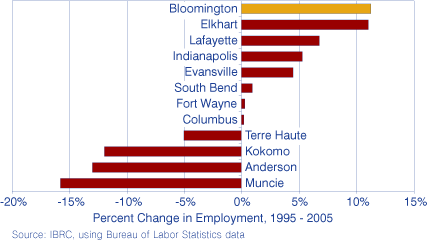
Targeted Industry Clusters
The life science (1) and information technology industries are an economic development focus of communities across the nation, and the Bloomington area is no exception. Recent data shows that Monroe County, as well as the greater Bloomington Metropolitan Statistical Area (MSA), which includes Greene and Owen counties, are seeing tremendous growth in these key clusters.
Figure 3 examines these and other clusters or sectors using location quotients (LQs), an indicator of industry specialization that compares, in this instance, the share of local employment in a particular cluster to the share of employment in that same cluster nationally. In the graphic, the horizontal line (LQ=1.0) represents the national average. Bubbles above the x-axis represent local industry specialization, (2) while those below it are less specialized locally. Those to the right of the y-axis have LQs that are growing over time—that is, those clusters or sectors are becoming relatively more specialized. The size of each bubble refers to the average wage per job of the cluster or sector.
Figure 3: Monroe County and Bloomington MSA Location Quotients and Average Wage per Job, 2005
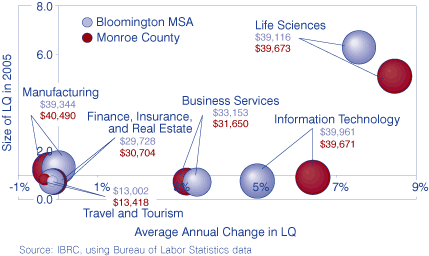
At first glance, the activity in the life sciences cluster stands out. The shares of the county and MSA employment in this cluster are more than five and six times greater than the national average, respectively. Additionally, Monroe County's degree of specialization in this cluster has increased by an average of 8.5 percent annually. Also noteworthy is the recent expansion of Bloomington's IT cluster which, from 2003 to 2005, saw its employment increase 87 percent to its current level of nearly 1,400 jobs. Although the local share of employment in this industry remains slightly below the national average, its concentration is growing at an impressive rate.
The lone sour note would be that the average local wages in both of these targeted clusters are barely half of the national averages. In the case of life sciences, the wage discrepancy reflects the dominance of manufacturing and production employment (97 percent) rather than the higher-wage research and development jobs.
Income
Figure 4 details the Bloomington area's per capita personal income (PCPI) as a percent of the U.S. average since 1969. The county's PCPI has consistently lagged the national average, which is not surprising for a community with a sizable student population. However, there has been an impressive upswing in this indicator since 2001, bringing the local PCPI to 83.5 percent of the national average—a gain of almost 6 percentage points in just a few years and the highest level in decades.
Figure 4: Monroe County Per Capita Personal Income as a Percent of the Nation, 1969 to 2004
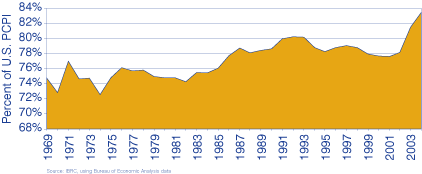
National Peer Comparison
An important component of the benchmarking study was to compare Bloomington's performance in a range of indicators against a set of national peers (see Figure 5). These peer communities were selected because they shared similar economic and demographic characteristics with Bloomington and were home to a major research university. As the following two examples indicate, Bloomington did not always stack up well relative these communities.
Figure 5: U.S. Peer Group
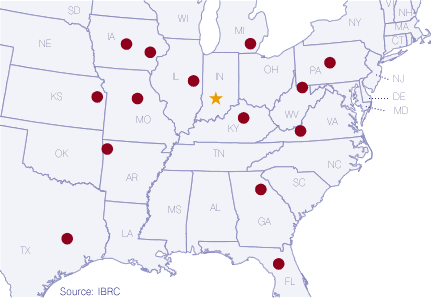
The national peers generally perform quite well in terms of unemployment, with each community well below the 2005 U.S. unemployment rate of 5.1 percent (see Figure 6). With unemployment rates of 3 percent, the southern towns of Fayetteville, Ark., and Gainesville, Fla., tied for the lowest levels of the group.
Figure 6: Average Unemployment Rates Among U.S. Peers, 2005
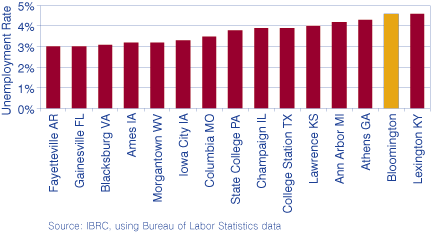
The Bloomington area, meanwhile, recorded an unemployment rate of 4.6 percent in 2005. This mark ties Bloomington with Lexington, Ky., for the highest unemployment rate among the peer set.
In terms of real PCPI, Bloomington ranked 11th out of the 15 communities. As Figure 7 illustrates, however, Monroe County's 18 percent growth in real PCPI over the last 10 years places it in the top half of this group.
Figure 7: PCPI and 10-Year Growth among U.S. Peers
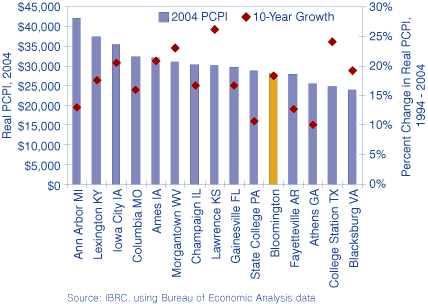
Data-Driven Economic Development
Ron Walker, President of the Bloomington Economic Development Corporation (BEDC), is encouraged by the study's findings. "Although the results are somewhat mixed," Walker noted, "we believe our economy is performing moderately well and poised to get even stronger."
Furthermore, Walker points out that timely and accurate information will increasingly drive economic development initiatives in Bloomington. "As the BEDC progresses, we will greatly emphasize data in the implementation of our economic development strategy. The benchmarking report provides a basis for us to measure job growth and prosperity in our economy, and over time we will work with our partners to integrate new metrics relating to sustainability, quality of place, income equality and business dynamics."
Notes
- The life science cluster should not be confused with the health care and social services industry. The life science cluster is concerned primarily with the research, development and manufacturing of medical devices and pharmaceuticals while the health care industry represents health care delivery.
- For instance, if the manufacturing sector accounted for 12 percent of workers locally but 10 percent nationally, its local LQ would equal 12/10, or 1.2.
Matt Kinghorn, Economic Research Analyst
Indiana Business Research Center, Kelley School of Business, Indiana University
